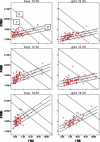The Effect of Body Build and BMI on Aerobic Test Performance in School Children (10-15 Years)
- PMID: 24357967
- PMCID: PMC3861773
The Effect of Body Build and BMI on Aerobic Test Performance in School Children (10-15 Years)
Abstract
Body Mass Index (BMI) has often questionably been used to define body build. In the present study body build was defined more specifically using fat free mass index (FFMI = fat free mass normalised to the stature) and fat mass index (FMI = fat mass normalised to stature). The body build of an individual is 'solid' in individuals with a high FFMI for their FMI and is 'slender' in individuals with a low FFMI relative to their FMI. The aim of the present study was to investigate the association between aerobic test performance and body build defined as solid, average or slender in 10 to 15 year old children. Five-hundred-and-two children (53% boys) aged 10 to 15 years of age were included in the study. Aerobic test performance was estimated with an incremental cycle ergometer protocol and a shuttle run test. BMI and percentage fat (by skin folds) were determined to calculate FMI and FFMI. After adjustment for differences in age, gender and body mass the solid group achieved a significantly higher maximal power output (W) and power output relative to body mass (W/kg) during the cycle test (p < 0.05) and a higher shuttle-run score (p < 0.05) compared to the slender group. The power output relative to FFM (W/kg FFM) was comparable (p > 0.05) between different body build groups. This study showed that body build is an important determinant of the aerobic test performance. In contrast, there were no differences in aerobic test performance per kilogramme FFM over the body build groups. This suggests that the body build may be determined by genetic predisposition. Key PointsChildren with a solid body build perform better in aerobic exercise tests than slender children.The power output relative to fat free mass was comparable in the solid, slender and average group.Besides body composition, body build should be considered related to other performance measurements.
Keywords: BMI; Shuttle run test; cycle test; percentage fat; slender body build; solid body build.
Figures

Similar articles
-
Reference norms for a fat-free mass index and fat mass index in the Japanese child population.J Physiol Anthropol Appl Human Sci. 2003 Nov;22(6):293-8. doi: 10.2114/jpa.22.293. J Physiol Anthropol Appl Human Sci. 2003. PMID: 14646264
-
Do changes in body mass index percentile reflect changes in body composition in children? Data from the Fels Longitudinal Study.Pediatrics. 2006 Mar;117(3):e487-95. doi: 10.1542/peds.2005-0572. Pediatrics. 2006. PMID: 16510627
-
Effect of body build on weight-training-induced adaptations in body composition and muscular strength.Med Sci Sports Exerc. 1994 Apr;26(4):515-21. doi: 10.1249/00005768-199404000-00018. Med Sci Sports Exerc. 1994. PMID: 8201909
-
Effect of fat mass index, fat free mass index and body mass index on childhood blood pressure: a cross-sectional study in south China.Transl Pediatr. 2021 Mar;10(3):541-551. doi: 10.21037/tp-20-325. Transl Pediatr. 2021. PMID: 33850812 Free PMC article.
-
BMI does not capture the high fat mass index and low fat-free mass index in children with cerebral palsy and proposed statistical models that improve this accuracy.Int J Obes (Lond). 2019 Jan;43(1):82-90. doi: 10.1038/s41366-018-0183-1. Epub 2018 Sep 4. Int J Obes (Lond). 2019. PMID: 30181652 Free PMC article.
References
-
- Armstrong N., Welsman J.R., Kirby B.J. (1998) Peak oxygen uptake and maturation in 12-yr olds. Medicine Science Sports Exercise 30, 165-169 - PubMed
-
- Brownson R.C., Boehmer T.K., Luke D. A. (2005) Declining rates of physical activity in the United States: what are the contributors?. Annual Review of Public Health 26, 421-443 - PubMed
-
- Eisenmann J.C. (2004) Physical activity and cardiovascular disease risk factors in children and adolescents: an overview. Canadian Journal of Cardiology 20, 295-301 - PubMed
-
- Eliakim A., Burke G.S., Cooper D.M. (1997) Fitness, fatness, and the effect of training assessed by magnetic resonance imaging and skinfold-thickness measurements in healthy adolescent females. American Journal of Clinical Nutrition 66, 223-231 - PubMed
LinkOut - more resources
Full Text Sources
